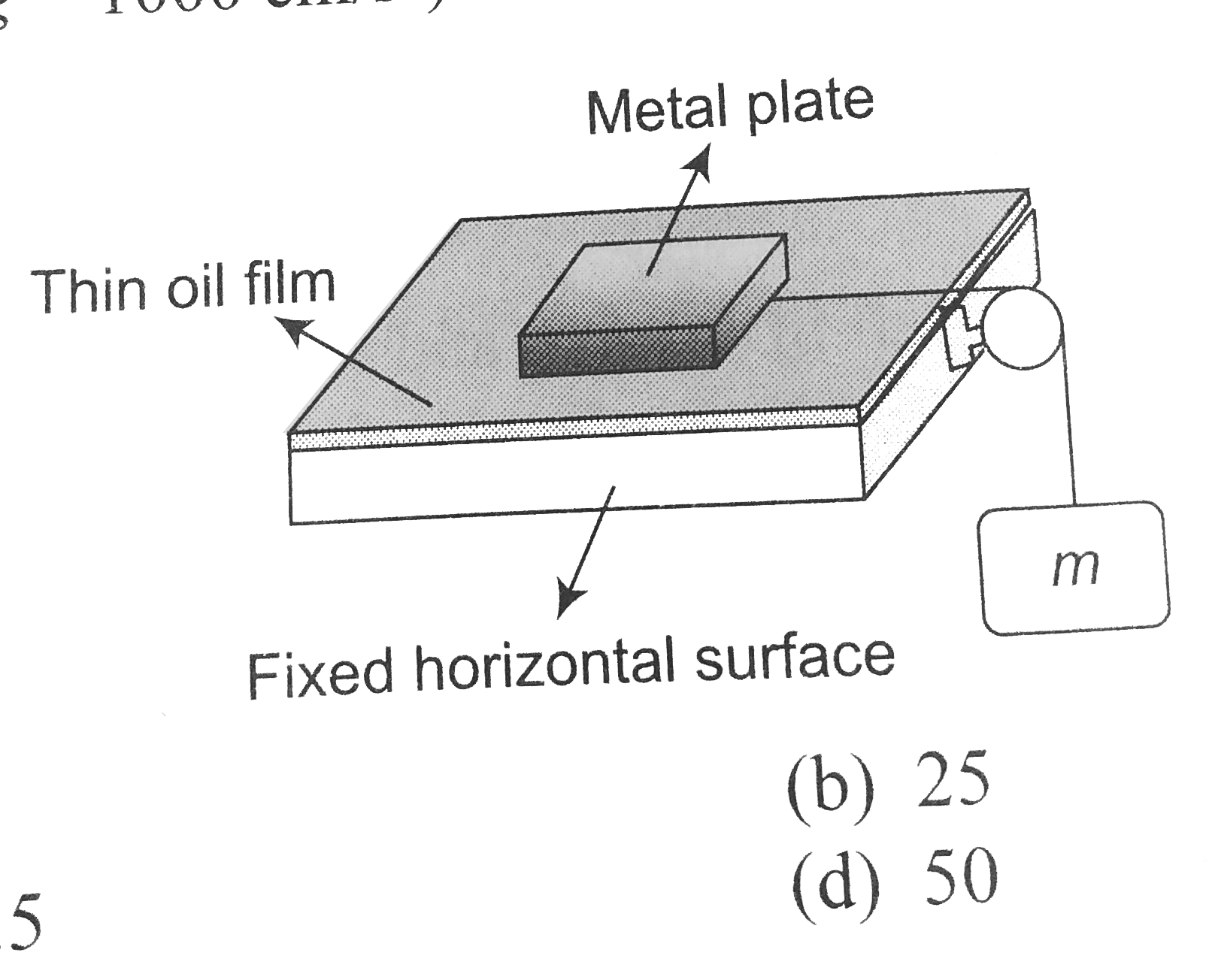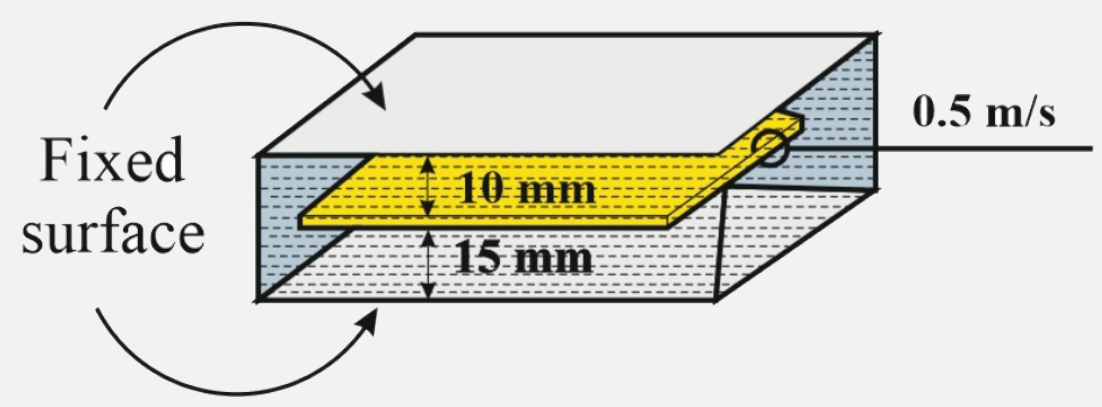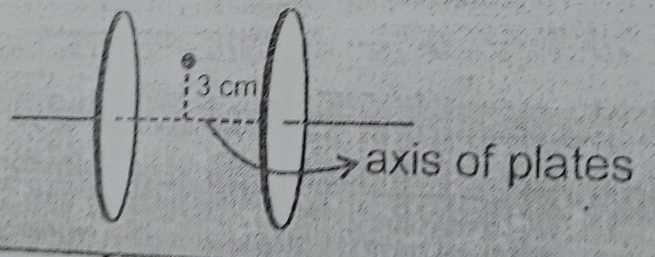The space between two large plane surfaces is 2.5 cm and it is filled with glycerine.
What force is required to drag a very thin plate 1m2 in area, between the surfaces at a speed of 1m/s ? (The plate is at a distance of 1 cm from one of the surfaces. ) (η=0.75Ns/m2)
100 N
75 N
50N
125 N
The correct Answer is:D
To solve the problem, we need to calculate the force required to drag a thin plate of area 1m2 between two large plane surfaces filled with glycerine. The viscosity of glycerine is given as η=0.75Ns/m2, and the distance between the surfaces is 2.5cm (or 0.025m). The plate is positioned 1cm (or 0.01m) from one surface, which means it is 1.5cm (or 0.015m) from the other surface. The speed of the plate is 1m/s.
1. Identify the parameters:
- Area of the plate, A=1m2
- Viscosity of glycerine, η=0.75Ns/m2
- Speed of the plate, v=1m/s
- Distance from one surface, z1=0.01m
- Distance from the other surface, z2=0.025m−0.01m=0.015m
2. Calculate the velocity gradient dvdz for both surfaces:
- For the upper surface (distance z1):
dvdz1=vz1=1m/s0.01m=100s−1
- For the lower surface (distance z2):
dvdz2=vz2=1m/s0.015m=66.67s−1
3. Calculate the viscous force F1 acting on the upper surface:
F1=−ηA(dvdz1)=−0.75Ns/m2×1m2×100s−1=−75N
4. Calculate the viscous force F2 acting on the lower surface:
F2=−ηA(dvdz2)=−0.75Ns/m2×1m2×66.67s−1=−50N
5. Calculate the net force F:
F=F1+F2=−75N−50N=−125N
The negative sign indicates that the viscous force acts in the direction opposite to the motion.
6. Final Result:
The magnitude of the force required to drag the plate is:
F=125N
- Area of the plate, A=1m2
- Viscosity of glycerine, η=0.75Ns/m2
- Speed of the plate, v=1m/s
- Distance from one surface, z1=0.01m
- Distance from the other surface, z2=0.025m−0.01m=0.015m
- For the upper surface (distance z1):
dvdz1=vz1=1m/s0.01m=100s−1
- For the lower surface (distance z2):
dvdz2=vz2=1m/s0.015m=66.67s−1
F1=−ηA(dvdz1)=−0.75Ns/m2×1m2×100s−1=−75N
F2=−ηA(dvdz2)=−0.75Ns/m2×1m2×66.67s−1=−50N
F=F1+F2=−75N−50N=−125N
The negative sign indicates that the viscous force acts in the direction opposite to the motion.
The magnitude of the force required to drag the plate is:
F=125N
Similar Questions

A space 2.5cm wide between two large plane surfaces is filled with oil. Force required to drag a very thin plate of area 0.5m2 just midway the surfaces at a speed of 0.5msec is 1N. The coefficient of viscosity in kg−sm2 is:
View SolutionThe space between two large horizontal metal plates, 6cm apart, is filled with a liquid of viscosity 0.8N/m2 . A thin plate of surface area 0.01m2 is moved parallel to the length of the plate such that the plate is at a distance of 2m from one of the plates and 4cm from the other. If the plate moves with a constant speed of 1ms−1, then
View SolutionFind the minimum force required to drag a hard polythene plate of area 2m2 on a thin film of oil of thickness 0.25cm and η=15 poise. Assume the speed of the plate is 10cms−1.
View SolutionThe total surface area of a solid cylinder is 616cm2. If the ratio between its curved surface area and total surface area is 1 : 2, find the volume of the cylinder.
View Solution
A rectangular metal plate has dimensions of 10cm×20cm. A thin film of oil separates the plate from a fixed horizontal surface. The separation between the rectangular plate and the horizontal surface is 0.2mm. An ideal string is attached to the plate and passes over an ideal pulley to a mass m. When m=125gm, the metal plate moves at constant speed of 5cms, across the horizontal surface. Then the coefficient of viscosity of oil in dyne−scm2 is (Use g=1000cms2)
View SolutionCalculate the force required to take away a flat circular plate of radius 0.02m from the surface of water. The surface tension of water is 0.07Nm−1
View SolutionTwo square metal plates of side 1m are kept 0.01m apart like a parallel plate capacitor in air in such a way that one of their edges is perpendicualr to an oil surface in the a tank filled with an insulating oil. The plates are connected to a battery of emf 500V. The plates are then lowered vertically into the oil at a speed of 0.001ms−1. Calculate the current drawn from the battery during the process.
(Dielectric constant of oil =11,ε0=8.85×10−12N−1m−2).
View SolutionThe total surface area of a solid cylinder is 616cm2. If the ratio between its curved surface area and total surface area is 1:2, find the volume of the cylinder.
View SolutionGlycerine is filled in 25 mm wide space between two large plane horizontal surfaces. A thin plate of area 0.75m2 at a distance of 10 mm from one of the surfaces is in a horizontal position be the plates inside the glycerine. It is dragged horizontally at a constant speed of 0.5ms2. Take coefficient of viscosity η= 0.5 Ns m−2. What is the force required to drag the plate at a constant speed (in newton) ?

View SolutionTwo circular plates of radius 0.1m are used to from a parallel plate capacitor. If displacement current between the plates is 2π.ampere, then find m agnetic filed produced by displacement current 4 cm from the axis of the plates.

View Solution
